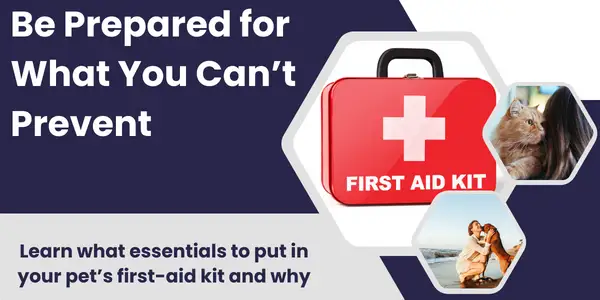
If you’re considering fostering a cat or kitten for your local animal shelter or rescue group, THANK YOU! We want to help you prepare by sharing our experience as volunteer cat fosters. In this article, we’ll take you through the application process and the various ways rescue organizations help find the right foster cat or kitten for you.
In the first two articles of our Fostering 101 series, we talked about the overwhelming need for foster homes for cats (not to mention for dogs, birds, rabbits, farm animals, and just about anything else covered in fur, feathers, or scales).
We also discussed some of the important considerations and questions to ask yourself to determine your best foster scenario. If you missed it, take a minute and check those out:
Once you’ve determined what type of foster situation will work best for you – call it your “foster plan” — it’s time to officially get the ball rolling.
Choosing a Foster Animal Rescue
Your first step is selecting a rescue organization to work with. We covered the different types and things to look for in our last article. Essentially, you’re just looking into their policies and procedures, making sure your situation meets their guidelines and trying to find a program that meshes well with your foster plan. To find a cat rescue near you in need of foster volunteers, use this search directory from Petfinder.
You might consider registering with more than one organization. However, most organizations don't want you to foster cats from other facilities while fostering one of theirs. This is because they can’t be sure of the health, vaccination status, etc., of foster cats that aren’t in their care. However, you may find you have downtime between new foster cats with your primary rescue, and another group may need foster volunteers. Be sure to discuss this with your rescue of choice and make sure you’re clear on their rules.
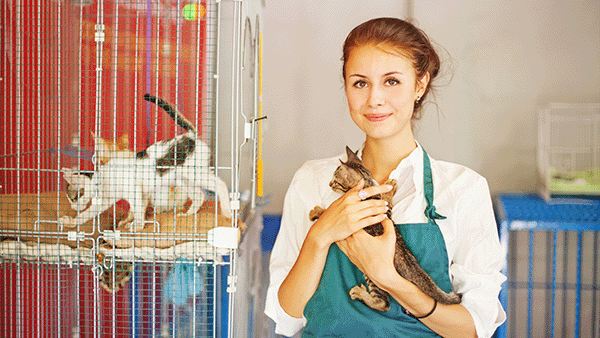
I have two areas of interest in cat fostering: medical cases and pregnant mothers. I’m currently approved with two different rescues. One focuses on adult cats and has a regular influx of medical cases. The other organization takes mothers and babies from facilities that don’t have the resources or available space to handle their special needs.
They often need a commitment from a foster home before they can agree to accept the transfer. It’s also one of the largest rescues in the area, and they have a solid roster of foster homes. For obvious, adorable reasons, kittens are placed quickly. So, I do most of my fostering through the first organization but always have the option to help the second group if they need support for a new transfer.
When you've done your research and are ready to start the application process, they'll either request you send an email or have an application on their website that you can fill out.
Applying to Become a Cat Foster
Different rescues handle foster applicants in different ways. Here are some of the things you can expect:
- You'll provide basic information such as age, living situation (rent, own, single, children, etc.), experience with animals, the types of fosters/situations you're interested in, and those you want to avoid. It may take them a little time to get back to you. Most rescues are relying on one person to do the work of five people in every department. These are busy, dedicated folks. Don’t worry if you don’t hear back right away.
- Many rescues will do a background check for foster applicants. This might be a general background check, or they might dive deeper and ask for personal references. It’s part of their process to ensure the safety of the animals.
- There may be a small application fee to cover their costs in processing the application forms.
- They should do a phone or in-person interview, taking you through a lot of the same questions we discussed in "How to Become a Foster Cat Guardian."
- They should give you the opportunity to tour their facility if they have one.
- Some require you to take a short informational class, either online or in person. The one I attended was just an hour long, and I found it extremely helpful. In addition to reviewing their policies, they also spent time going over the various types of cases they place with fosters and what it takes to manage them. For example, the difference between fostering a healthy animal, a dog or cat with ringworm, an upper respiratory infection, kittens or puppies who haven’t been weaned, etc.
- They may require a home check, sending someone from the foster care team to walk through your space. It might sound inconvenient, but it’s simply another way they keep the animals safe, and it’s an absolute breeze. My rescue actually did the home check when they brought my foster cat to me. We spent 30 minutes watching kitty explore, making sure she was comfortable, and that was that.
Take a look at a couple of foster application examples from rescues around the country:
You only have to go through this application once for each organization you want to register with — though some will let you use a single background check for multiple rescues. When everything is approved, and you’ve completed any necessary interviews or training (which, again, are very minimal, so don’t let this sideline your plan), you’ll go on the foster volunteer list.
PRO TIP: If, at any point, you don’t feel good about the rescue – whether it’s because they don’t let you tour the facility, don’t seem engaged on the phone, or you just don’t think they’re putting the animals first – listen to your gut and either do more research, ask for a foster family reference you can connect with, or talk to another organization. I’ve never run into this myself. But there are less-than-reputable groups out there. So just be aware.
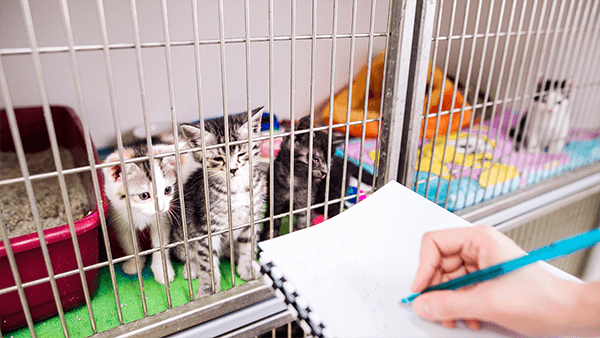
How You are Matched with a Foster Cat
When it comes to finding a foster cat or kitten best matching your foster plan, it’s a different process for different rescues. They should clearly explain how it works during the interview.
Let Them Know When You’re Ready
Give your rescue a heads-up that you’re ready to foster a cat, and they’ll reach out as soon as they have a foster kitten or cat that they think is the right fit. Often, they’ll have more than one, so they’ll walk you through the important details of each and see how you feel. There’s no pressure here! If you think there’s a match, great. If not, that’s ok. You just hang tight until they have a better fit. Many rescues are happy to give you some time to think about it. But generally, they send you an email with more specifics and an adorable photo, and that does it. You’re in.
My second foster came to me this way … sort of. I reached out to the rescue organization, and the foster manager suggested I foster Oliver, a cat surrendered by his family when they moved overseas. I was invited down to meet him before making a final decision. They even took the time to walk me through the cat room and share the stories of the different cats in their care. Understandably, Oliver was an emotional wreck, hissing, and biting, with no reason to trust anyone. I took the leap and said yes to being his foster guardian. Arrangements were made for me to pick him up a few days later. But, wonderfully, within that time a family saw his story and decided to adopt him, even in his aggressive and fragile state.
When I learned Oliver wouldn’t need a foster home, my mind went back to a beautiful little tiger tabby I’d met on the tour named Bettina. She was awaiting an amputation from a severe leg injury. Thankfully, they felt she’d be a great fit for me, and I cared for her for many wonderful months. You can read about her journey and how to help your cat through major surgeries in What to Expect After Your Cat’s Surgery.
Bettina just a few hours after I brought her home, and I’m already covered in cat fur.
Bettina a few months later, after her amputation. One less leg but as cuddly as ever.
My current foster cat was a much simpler process. I let them know I was ready, and they called a couple of weeks later about two or three cats they thought I’d be interested in. It just happened they had another tiger tabby like Bettina, but male, about the same age and also expected to need an amputation. It was fate. I picked him up two days later. His name is Ollie, not to be confused with my cat Ollie, who I’m going to gush about further below.
Foster cat Ollie on day three, sitting on my lap for the first time. That’s my lap. The thing that looks like a fluffy, plaid pillow.
Of course, these were both serious medical cases. Not all fosters are medical in nature, but I specialize in fostering cats with medical needs.
Check the List of Available Foster Cats and Kittens
Some rescues have a private web page or regular email that goes out to all of their approved foster homes, listing all the animals they have available to foster at that time. These lists include any special needs, expected length of foster stay and any information you'd need to start a conversation. For high-volume rescues, these lists can go out as often as weekly, with 10 or more new dogs and cats each week.
If you’re interested in a particular foster kitten or cat (or multiple cats), let them know. They’ll go through all the responses and match each cat to the best foster home.
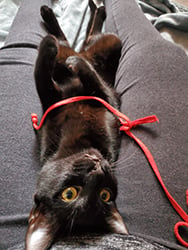
And that’s how I met my pet cat Ollie. He was a respiratory infection case. The rescue wanted to move him to foster care for one week and then back to the shelter for adoption. It must have been fate that I was selected for him, even though I’d expressed interest in a few other cats on the list.
As I sat with him in my arms the day before he was supposed to go back to the rescue, surprised by how emotional I was at the prospect of handing him over, it dawned on me … I can adopt him! I’ve had animals my entire life and shared some unbelievable bonds with all of them. But what I felt with this cat, after only a week, was unlike anything I’d felt before. I love him more every minute of every day.
Ollie on our first day together. Let the love affair begin.
Rescue Needs Foster Help
Other rescues may reach out to you directly when they have a case come in that fits your profile. In some situations, if your rescue takes transfers from other organizations, they may not be able to accept the transfer until they have foster homes in place for all of the animals involved. Fostering really is vital to the rescue process.
And again, you’ll make the final decision. It’s entirely up to you. Maybe you have a vacation coming up, guests in town, or a particularly busy couple of months at work. Discuss this with your foster care team, and you can decide, with their advice, if you want to move forward or hold off.
An Important Note About “Ownership” of Foster Animals
While a foster is in your care, it’s important to remember that the rescue is technically the cat’s owner. The foster home is acting as the caregiver. But the rescue makes all decisions and provides you with instructions.
We’re talking about things like:
- Diet: what type of cat food to feed your foster cat or kitten and their feeding schedule.
- Medical treatment plans including deciding which veterinarians and specialists your foster cat will see, what procedures they will have, and scheduling (or working with you to schedule) appointments.
- Approval of the adopting person or family.
For all intents and purposes, if it goes beyond general day-to-day care, the rescue makes the plan. This doesn't mean you shouldn't speak up if you have concerns or feel they may be overlooking something. You should undoubtedly act as an advocate for your foster. But any reputable rescue exists for the sole purpose of helping animals. They’re not likely to act irresponsibly. And they’re generally very interested in the foster guardian’s point of view. In some cases, they even have the foster guardian meet potential adopters if you’re keeping the cat until the adoption is complete. The final decisions, however, will be theirs.
This can cause a little tension, more so when dealing with medical cases. But as you build a rapport with your foster care team and get more comfortable with the flow of rescue work, you’ll be just fine. And remember, you can always speak up and ask questions. A good animal rescue team will appreciate how dedicated you are to your foster and be happy to share their reasoning.
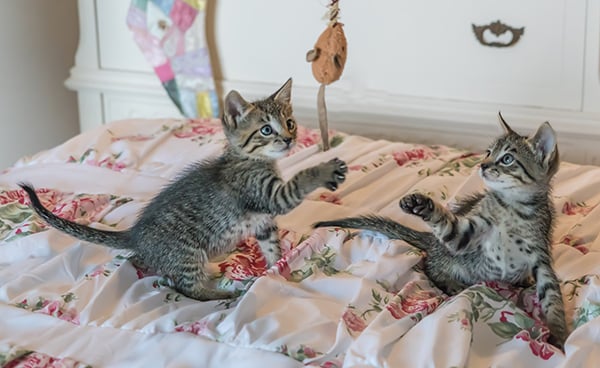
The Foster Information Kit
Once you’ve been matched with your foster cat or kitten, you’ll make arrangements to pick them up. At that time, you’ll receive a packet of information. The kit or handbook generally includes:
Tips on Caring for Your Foster Cat and Rescue Organization's Procedures
- What to expect in the first few days with your new foster kitten or foster cat.
- If the rescue is providing food, litter or medication, and the process for requesting refills.
- Procedures if you’re leaving town and need someone to care for your foster cat. In most cases, the rescue will require you to board the cat with them vs. having a friend care for the cat or bringing them to a pet sitter.
- Things you can do to help the rescue find a great adopter, such as taking photos, videos, note personality traits, etc.
- Safety procedures, including if, when, and how foster cats are allowed outside.
- Daily care reminders like grooming and exercise.
An Emergency Medical Care Guide for Your Foster Cat
Every rescue should have clear instructions for medical emergencies. These generally include:
- A list of qualifying emergency conditions. Remember, the rescue probably has an in-house veterinarian or partners with a clinic for discounted services. Outside medical treatment is likely to cost the rescue considerably more. It’s important to know what warrants a trip to the animal emergency clinic.
- A list of local emergency veterinary hospitals that partner with the rescue.
- The rescue phone number to be called if an emergency happens during business hours.
- Another after-hours rescue phone number (or other instructions) for emergencies occurring when the rescue is closed.
- Clear instructions on what to do while you’re at the emergency hospital. What information to provide to the hospital, and how to follow up with the rescue during and after the process.
Keeping a copy of a pet first aid manual handy can be helpful for you in case of emergency. We recommend The First-Aid Companion for Dogs & Cats. The VCA Veterinary Specialty Care Center of Seattle has also posted a fantastic Pet Emergency Care Handbook online.
PRO TIP: Knowing what to do (and what not to do) if your foster cat gets injured, becomes ill, or otherwise needs first aid is important. Consider taking a pet first-aid class and make sure you have a first-aid kit for your cat so you'll have the supplies you might need.
Talk to your rescue before an emergency happens to see if there are any instances in which you, the foster caregiver, would be responsible for the cost of veterinary care. Generally, the rescue handles all expenses. But it’s possible if the emergency is the result of inadequate care or if the cat is taken to the emergency clinic when it could have been taken to the rescue’s in-house veterinary services, the foster family may be responsible for costs.
This is NOT always the case. It’s an important conversation to have, ideally BEFORE you pay for emergency veterinary care. But if you can't get a hold of the rescue organization, you'll have to use your best judgement for the care of your foster cat.
The Foster Agreement
This is a form you sign, acknowledging your role and commitment to your foster cat. It usually includes:
- General care and safety guidelines:
- Getting your foster kitten or cat to any necessary appointments, providing regular updates on your foster’s health and wellness, keeping them indoors when required, providing safe play and exercise spaces, etc.
- Behavior and training: Committing to work with your foster on general socialization and basic training.
- Vacation and time off: Your agreement not to leave your foster in the care of anyone other than the approved caregiver, the rescues commitment to offer boarding, etc.
- Health care and emergencies: Agreeing to give medications and food as directed, what you will do if your foster pet is lost or stolen, what you will do in case of emergency, etc.

My current foster agreement with the organization I volunteer with includes specifics on the medical expense liability question I mentioned above. It states, “I understand as the Foster that I am not responsible for paying for veterinary care while the pet is in my care; although I understand that if the pet must see a veterinarian out of my negligence, then it is my responsibility to pay the bill.”
The Foster Agreement is a Legal Document
This is a legal document you’re signing. Give it a thorough review to ensure you know exactly what’s expected of you and what support the rescue will provide. Here’s an example of what a foster agreement looks like from Pima Animal Care Center.
Another important point, sometimes covered in the foster agreement, is what happens if the foster cat is found to have a contagious condition that subsequently infects your personal pets. Have this conversation with your rescue. Some illnesses can be transmitted to other pets. Although this does not happen very often, it is a risk to consider.
Sadly, I can speak from experience on this one. After initially testing negative, one of my fosters was unexpectedly found to have feline leukemia, a highly contagious and very serious disease. It’s rare to have a cat test negative and then positive a few months later, while in the care of rescue organizations or foster guardians. My rescue immediately offered free testing for my pets and assured me they’d help with any long-term care if they tested positive. Thankfully, even after months living alongside this foster cat, my pets were all ok. I will continue to test them yearly, just in case.
In Closing
And that’s it! A little research, a little paperwork, a little waiting, and you’re on your way to whiskers, toe beans, and a lot of fur. You’ve already come this far, so don’t stop now. Your foster kitty is out there and ready when you are!
Related Articles
- Foster Cats 101: Why You Should Consider Fostering a Cat
- Foster Cats 101: How to Become a Foster Cat Guardian
- Foster Cats 101: Applying to Be a Cat Foster Volunteer
- Foster Cats 101: Your First Foster Cat — Set Up and What to Expect
- Foster Cats 101: Caring for Your Foster Cat
- Foster Cats 101: How to Help Your Foster Cat Get Adopted
- Foster Cats 101: Saying Goodbye to Your Foster Cat
- Where to Put Your Cat After Surgery and How to Care For Them
- Cat Enrichment: What to do When Your Cat is Bored



